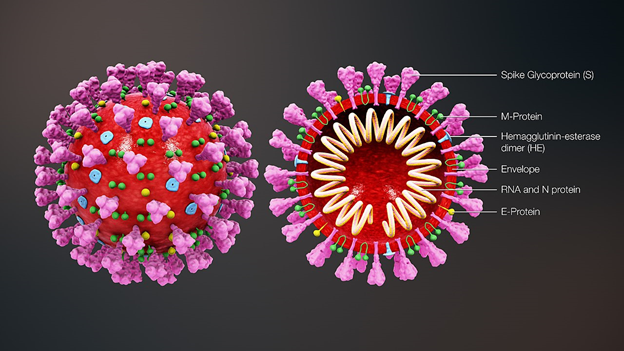You may have heard about the massive number of COVID-19 tests being run as colleges try to bring students back to campus. These “rapid” antigen tests provide results in 15 min, but how does that work and is it as good as the RT-PCR test? A #SciCommSunday thread.
Let’s start by taking a look at the structure of the SARS-CoV-2 virus – that’s the virus that causes COVID-19. The virus has an outer shell made up of different proteins and that surrounds a molecule called RNA.
The RNA molecule carries all of the instructions needed to make the proteins, and that is how a virus can hijack the machinery of your cells to make more copies of itself and cause an infection to spread throughout your body.
RNA and protein are both polymers, meaning that they are long chains made up of different combinations of smaller molecules. For RNA, these subunits are called “nucleotides” and for proteins they are called “amino acids.”
While they are both polymers, they are made in different ways. RNA is able to be replicated, meaning that cells can take a sequence of RNA and make lots of copies of it, kind of like having a page of instructions and being able to make photocopies.
In comparison, cells can use the RNA to make proteins, but proteins can’t be directly copied. They are kind of like a desk or bookshelf you might build using the instructions.
When you hear about an RT-PCR test, that is a test that is detecting the RNA molecule from the virus. Running these tests is complicated because the RNA has to be carefully extracted from the protein coat without it being destroyed.
However, these tests are also quite sensitive because they can use the same process that happens in your cells to take a small number of RNA molecules and copy those into a larger number of DNA molecules, which are then easier to detect.
In comparison, the more recently authorized “antigen” tests are detecting the protein shell for the virus. They do this using antibodies, which are a different type of protein, and are actually the same thing that your body makes to fight off infection.
The antibodies can bind specifically to the outer shell of the virus and researchers have used this to make test strips that work kind of like a pregnancy test – if the virus is present, antibodies cause it to get stuck at a specific location on the strip and that makes a signal.
Antigen tests can be much faster than RT-PCR tests because they don’t require the RNA extraction and copying steps. However, this can come with a tradeoff in sensitivity. Without the copying step, there are fewer molecules to be detected.
One of the antigen tests recently approved by the FDA for emergency use only caught 84% of the positive cases that were found using the RT-PCR test. So, a negative on the antigen test doesn’t necessarily mean that someone is not infected, especially if they are symptomatic.
However, antigen tests have the benefit that they are simpler and faster than RT-PCR tests, meaning that it could be feasible to test much more often and for larger numbers of people.
As we try to find safe ways to return to our normal activities, testing will certainly continue to play a central role. There is currently no single test that is cheap and fast and offers very high accuracy, but the technology is improving at rapid speed. Until then, #WearAMask!

 Read on Twitter
Read on Twitter




